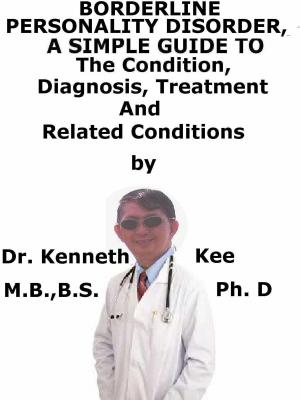Types Of Hemolytic Anemia, A Simple Guide To The Condition, Treatment And Related Conditions
Nonfiction, Health & Well Being, Medical, Specialties, Internal Medicine, Hematology| Author: | Kenneth Kee | ISBN: | 9781370197507 |
| Publisher: | Kenneth Kee | Publication: | December 12, 2016 |
| Imprint: | Smashwords Edition | Language: | English |
| Author: | Kenneth Kee |
| ISBN: | 9781370197507 |
| Publisher: | Kenneth Kee |
| Publication: | December 12, 2016 |
| Imprint: | Smashwords Edition |
| Language: | English |
Hemolytic anemia is the breakup of red blood cells in the blood earlier than normal.
Hemolytic anemia is a condition in which the body destroys too many red blood cells.
Inherited or acquired conditions or factors can cause hemolytic anemia.
Inherited hemolytic anemia is condition such as G6PD Deficiency.
Other examples include:
1. Immune disorders,
Immune hemolytic anemia occurs when the immune system mistakenly sees the own red blood cells as foreign substances.
Antibodies then develop against the red blood cells.
These antibodies attack the red blood cells and cause them to break down too early.
2. Infections
3. Certain medicines,
4. Reactions to blood transfusions.
Hemolytic anemia occurs when excessive red blood cells that are being destroyed before the bone marrow could replace them.
The body may also destroy red blood cells because of certain genetic defects that cause the blood cells to take on abnormal shapes (such as sickle cell)
1. Auto-Immune hemolytic anemia occurs when the immune system produces antibodies against the red blood cells.
These antibodies attack the red blood cells and cause them to break down too early.
2. Certain genetic defects such as sickle cell anemia, thalassemia, and hemolytic anemia due to G6PD deficiency
3. Exposure to certain chemicals, drugs, and toxins
4. Infections
5. Blood clots in small blood vessels
6. Transfusion of blood
Early Symptoms may include:
1. Fatigue or weakness with exercise
2. Feeling grumpy
3. Giddiness
4. Headaches
5. Concentration or thinking problems
These tests can identify the type of hemolytic anemia:
a. Absolute reticulocyte count
b. Coombs' test, direct
c. Coombs' test, indirect
d. Donath-Landsteiner test
e. Febrile or cold agglutinins
f. Free hemoglobin in the serum or urine
g. Hemosiderin in the urine
i. Protein electrophoresis - serum
j. Urine and fecal urobilinogen
k. Platelet count
l. Serum haptoglobin levels
m. Serum LDH
A test that measures how long red blood cells last using radioactive tagging techniques can also help diagnose hemolytic anemia
Treatment depends on the type and cause of the hemolytic anemia.
1. In emergencies, a blood transfusion may be needed.
2. For hemolytic anemia caused by an overactive immune system, drugs that suppress the immune system may be used.
3. Extra folic acid and iron supplements to replace what is being lost.
4. The spleen may need to be removed, because it acts as a filter, removing abnormal cells from the blood.
TABLE OF CONTENT
Introduction
Chapter 1 Hemolytic Anemia
Chapter 2 More Facts about Hemolytic Anemia
Chapter 3 Treatment of Hemolytic Anemia
Chapter 4 Anemia
Chapter 5 Sickle Cell Anemia
Chapter 6 G6PD Deficiency
Chapter 7 Iron Deficiency Anemia
Chapter 8 Thalassemia
Epilogue
Hemolytic anemia is the breakup of red blood cells in the blood earlier than normal.
Hemolytic anemia is a condition in which the body destroys too many red blood cells.
Inherited or acquired conditions or factors can cause hemolytic anemia.
Inherited hemolytic anemia is condition such as G6PD Deficiency.
Other examples include:
1. Immune disorders,
Immune hemolytic anemia occurs when the immune system mistakenly sees the own red blood cells as foreign substances.
Antibodies then develop against the red blood cells.
These antibodies attack the red blood cells and cause them to break down too early.
2. Infections
3. Certain medicines,
4. Reactions to blood transfusions.
Hemolytic anemia occurs when excessive red blood cells that are being destroyed before the bone marrow could replace them.
The body may also destroy red blood cells because of certain genetic defects that cause the blood cells to take on abnormal shapes (such as sickle cell)
1. Auto-Immune hemolytic anemia occurs when the immune system produces antibodies against the red blood cells.
These antibodies attack the red blood cells and cause them to break down too early.
2. Certain genetic defects such as sickle cell anemia, thalassemia, and hemolytic anemia due to G6PD deficiency
3. Exposure to certain chemicals, drugs, and toxins
4. Infections
5. Blood clots in small blood vessels
6. Transfusion of blood
Early Symptoms may include:
1. Fatigue or weakness with exercise
2. Feeling grumpy
3. Giddiness
4. Headaches
5. Concentration or thinking problems
These tests can identify the type of hemolytic anemia:
a. Absolute reticulocyte count
b. Coombs' test, direct
c. Coombs' test, indirect
d. Donath-Landsteiner test
e. Febrile or cold agglutinins
f. Free hemoglobin in the serum or urine
g. Hemosiderin in the urine
i. Protein electrophoresis - serum
j. Urine and fecal urobilinogen
k. Platelet count
l. Serum haptoglobin levels
m. Serum LDH
A test that measures how long red blood cells last using radioactive tagging techniques can also help diagnose hemolytic anemia
Treatment depends on the type and cause of the hemolytic anemia.
1. In emergencies, a blood transfusion may be needed.
2. For hemolytic anemia caused by an overactive immune system, drugs that suppress the immune system may be used.
3. Extra folic acid and iron supplements to replace what is being lost.
4. The spleen may need to be removed, because it acts as a filter, removing abnormal cells from the blood.
TABLE OF CONTENT
Introduction
Chapter 1 Hemolytic Anemia
Chapter 2 More Facts about Hemolytic Anemia
Chapter 3 Treatment of Hemolytic Anemia
Chapter 4 Anemia
Chapter 5 Sickle Cell Anemia
Chapter 6 G6PD Deficiency
Chapter 7 Iron Deficiency Anemia
Chapter 8 Thalassemia
Epilogue















